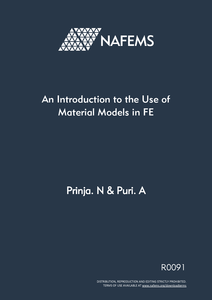
The use of computational techniques, like the finite element method, is increasingly becoming popular in engineering companies involved in the design and analysis of engineering components and structures made from a variety of materials. An important aspect of FE analysis is modelling of the material behaviour.
The aim of the book is to offer physical understanding of the material modelling features. This book is aimed at engineering students and professional engineers who are familiar with the finite element method and its terminology. It will be assumed that the reader’s experience is limited to carrying out linear stress analysis. A non-specialist reader will be able to follow the booklet and understand the important modelling issues, techniques and assumptions.
Examples have been used to illustrate the modelling techniques and also show the sensitivity of the results to the input data used to describe the material behaviour. The book will be useful to practising engineers as it will explain the physical significance of the various input data that has been used to describe the material behaviour.
A range of constitutive models typically used in an FE analysis is described in the book and where appropriate, material failure under severe loading is also covered. However, analysis of failure due to fracture, fatigue and buckling which require different procedures is not covered in this book.
NAFEMS has already produced a series of book which give guidance on how to create finite element models, select analysis codes and perform stress analysis. This book goes a step further and provides practical guidance on how to model material behaviour in a finite element analysis.
Contents
| 1. Introduction |
| 2. Classes of Materials |
| 3. Linear Elastic |
| 3.1 Isotropic |
| 3.2 Orthotropic |
| 3.3 Anisotropic |
| 4. Linear vs Non-linear |
| 5. Plasticity |
| 5.1 Yield Function |
| 5.2 Flow Rules |
| 5.3 Metal Plasticity |
| 5.3.1 Perfectly Plastic Material |
| 5.3.2 Isotropic Hardening |
| 5.3.3 Kinematic Hardening |
| 5.3.4 Non linear kinematic hardening |
| 5.4 Models for cyclic loading |
| 6. Concrete |
| 6.1 Modelling of Plain Concrete |
| 6.2 Modelling of Reinforced Concrete |
| 6.3 Post-Tensioned Concrete |
| 6.4 Concrete Cracking |
| 6.4.1 The Discrete Crack Approach |
| 6.4.2 The Smeared Crack Approach |
| 7. Foam and Wood |
| 7.1 Physical considerations |
| 7.2 Material Models for Crushable Foam |
| 8. Composites |
| 8.1 Material Classification |
| 8.2 Advantages and Disadvantages of Composites |
| 8.3 Fibres and Matrices |
| 8.4 Micromechanics and Macromechanics of Composites |
| 8.5 Generation of Material Design Data |
| 8.5.1 Material Constants |
| 8.6 Modelling of Composites |
| 8.6.1 Layered |
| 8.6.2 Equivalent Lamina Properties |
| 9. Rubber |
| 9.1 Physical Behaviour and FE Formulations |
| 9.2 Types of Hyperelastic Material Models |
| 10. Soils |
| 10.1 Physical considerations |
| 10.2 Mohr-Coulomb Model |
| 10.3 Drucker-Prager Model |
| 10.4 Matching Soil Parameters |
| 10.5 Cap Hardening |
| 10.6 Analysis Assumptions |
| 11. Creep |
| 11.1 Time Hardening |
| 11.2 Strain Hardening |
| 11.3 Creep Laws |
| 11.4 Analysis Procedures |
| 12. Applications of Material Models |
| 12.1 Aircraft Engineering |
| 12.1.1 Conventional aluminium alloy |
| 12.1.2 Aluminium-lithium |
| 12.1.3 Magnesium alloy |
| 12.1.4 Titanium |
| 12.1.5 Steel |
| 12.1.6 Carbon Fibre Composite |
| 12.1.7 Woven Cloth |
| 12.2 Medical Engineering |
| 12.3 Automotive Engineering |
| 12.4 Verification of Material Models |
| 13. Concluding Remarks |
| 14. References |



